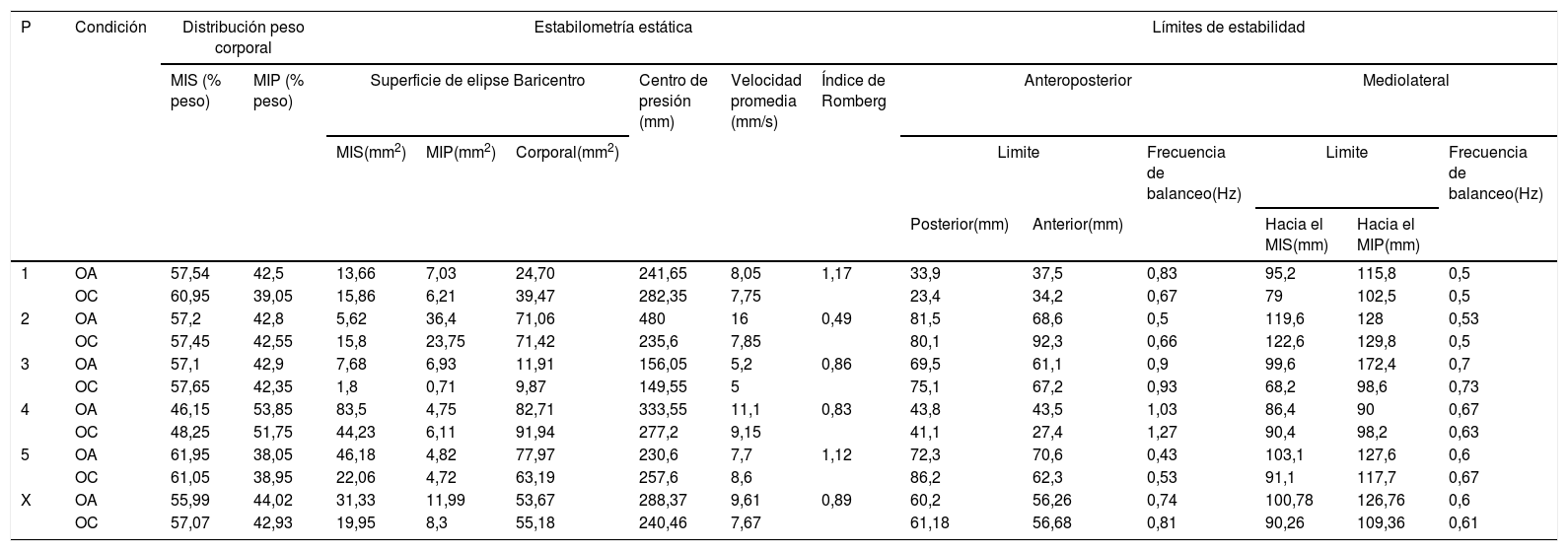La amputación de miembros inferiores genera ajustes en los sistemas somato sensorial y musculoesquelético modificando la manera como se mantiene la estabilidad, parámetro sensible y clínicamente relevante en la evaluación clínica. El objetivo de este trabajo fue determinar las características de la estabilidad en personas con amputación transtibial unilateral (ATU) en fase posprotésica.
Materiales y métodosEstudio descriptivo de serie de casos que incluyó 5 varones con ATU con marcha independiente y que no usaran dispositivos de asistencia. Se evaluó la estabilidad estática y dinámica con ojos abiertos (OA) y ojos cerrados (OC).
ResultadosLa estabilometría estática mostró una superficie de elipse de baricentro corporal mayor con OC y en el miembro inferior sano (MIS) respecto al miembro inferior protetizado (MIP), la media del índice de Romberg se ubicó en el rango de referencia; la estabilometría dinámica mostró límites de estabilidad menores en sentido anterior y hacia el MIS, y aún más reducidos con OC.
ConclusiónLas personas con ATU tienden a generar mayor apoyo y oscilaciones en el MIS y menores límites de estabilidad en el MIP para mantener el control de la estabilidad estática y dinámica.
The amputation of lower limbs leads to adjustments in somatosensory and musculoskeletal systems to modify the way that stability is maintained. This is a sensitive and relevant parameter within clinical evaluation. The objective of this study was to determine the characteristics of stability in patients with a unilateral transtibial amputation (TTA) in the post-prosthetic phase.
Materials and methodsA descriptive study of a case series including five men with TTA and an independent gait, and who did not use assistive devices. Static and dynamic stability was evaluated with open eyes (OE) and closed eyes (CE).
ResultsStatic stabilometry displayed a greater elliptical surface area of body centre of gravity with CE and in the Healthy Lower Limb (HLL) compared to the Prosthetic Lower Limb (PLL). The mean Romberg ratio (EC/EO) was within the reference range. Dynamic stabilometry showed lower limits of stability in the anterior direction and towards the HLL, and even more reduced stability with CE.
ConclusionPeople with TTA tend to generate more support and oscillations in the HLL and lower stability limits in the PLL to maintain static and dynamic stability control.
Artículo
Si ya tiene sus datos de acceso, clique aquí.
Si olvidó su clave de acceso puede recuperarla clicando aquí y seleccionando la opción "He olvidado mi contraseña".Comprando el artículo el PDF del mismo podrá ser descargado
Precio 19,34 €
Comprar ahora









